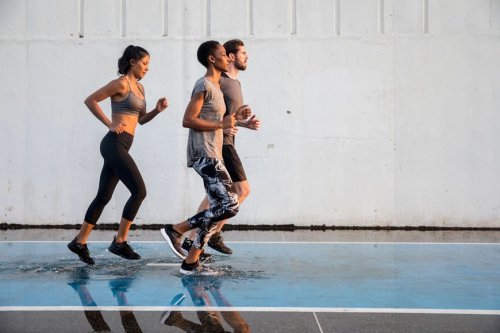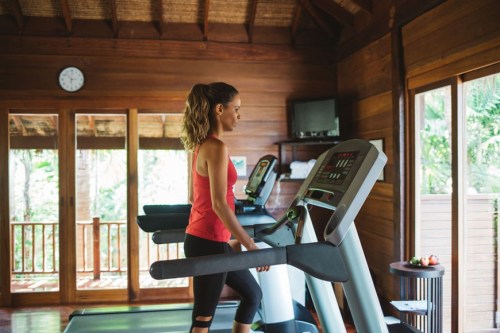The concept of a “runner’s high” has always been totally lost on me. Pounding the pavement has the exact opposite effect: I find it to be boring, which means that I’m extra-focused on the fact that it makes my joints hurt and my breathing labored. Like a lot of people, I simply don’t enjoy jogging.
So, is there anything that can be done to make the experience more fun? According to experts, there is—and they swear that once you find your running groove, you’ll never go back to a life without fartleks and negative splits.
Before you side-eye, it’s worth at least trying to learn to love lacing up your sneakers because there are some major health benefits that are unique to the sport, all of which go beyond its sizable calorie burn. “Any scientist will tell you the bone-density perks of running are so incredible,” says David Siik, creator of Equinox’s Precision Running program. “People who run at a moderate intensity, three days a week, have a lower incidence of hip replacement. There are also links between runners and a reduction in Alzheimer’s and dementia.”
“When it comes to mental health, running can provide as many benefits as medication, without side effects.”—Sepideh Saremi, run coach and psychotherapist
And what if you’re still a few decades away from worrying about cognitive decline? “Running causes your brain to release neurochemicals that increase happiness and reduce pain, which can help you improve your mood, general well-being, and how you feel about yourself,” says run coach and psychotherapist Sepideh Saremi. “It’s associated with increased creativity and self-efficacy, which is your faith in your ability to make things happen in your life. When it comes to mental health, running can provide as many benefits as medication, without side effects.”
Keep reading for tips on how to make running more fun if you’re really not in to it.

If you feel self-conscious while running, try doing it in a group
Whether you’re jogging around a park or slogging it out on a treadmill in the middle of your gym, it can sometimes feel like everyone’s looking at you—which is reason enough for many people to opt instead for a bike way in the back of a darkened spin class.
This is something Siik hears from his students all the time. “It’s about body comfort for some people,” he says. “Everything is so exposed now in fitness, and running is one of those things you can’t do in a pretty way.”
If this sounds familiar, the first thing to remember is that it’s not supposed to look pretty, and that’s the beauty of the sport. “I don’t care how ‘good’ or ‘bad’ you are, running is tough for everybody,” Siik says. “Which is why the reward is so enormous—it’s about as authentic and real as work gets. But, because of that, people are embarrassed.”
He adds that if insecurity’s getting the best of you, it helps to join a running class where each person in the group is doing the same thing and concentrating on their own workout. “You get lost in the sea of everyone else, and it becomes much less intimidating,” he says. “Know that it’s okay to feel uncomfortable in your body, but if you give it a chance, that discomfort will change very quickly.”

If running hurts, don’t automatically blame it on running
One of the reasons why I personally don’t love running is because it brings out all sorts of aches and pains that I don’t normally experience in my workouts—a stabby feeling in my knee one minute, an ankle or a shin the next. I’ve always attributed this to poor running form, but Siik says that there’s no such thing.
“Nobody has the ultimate running form,” he points out. “Running moderately should not hurt you, but it does expose other injuries and imbalances all the time. Injuries are the one thing people blame on running, but it’s usually something else in their life that running makes worse.”
So if your lower back starts aching after a quarter mile on the jogging path, it might be because you’re spending too much time on a bike each week and not enough time cross-training. In my case, I suspect my leg joint soreness has more to do with OD-ing on squats and lunges—staples in my daily workout routine—than sprints. The only way to know for sure is to ask an expert, says Siik. “A good running coach will give you so much valuable information,” he says.

If you’re bored on the treadmill, try doing intervals
For a lot of people, spending an hour on a treadmill at a single speed and incline is never going to be as fun as, say, a barre class. That’s why, if you’re doing a solo indoor run, Siik says it’s crucial to make it mentally engaging—and the best way to do that is through interval training.
If you’re not hitting up a running class, there are tons of training plans to be found online and on apps, all of which involve varying the speed and incline of your treadmill to alternate periods of hard work with recovery. “You have to have a plan, or you can’t fix that boredom,” Siik proclaims. “When your workout is beautifully structured, your mind flips a switch and running becomes a quest and a challenge.”
Aside from that, he recommends coming prepared with a killer running playlist and keeping your run short to fend off boredom—around 15 minutes to start. And if you’ve got a treadmill at home, make sure that you put it somewhere inspiring. “Put a mirror in front of it, put a candle there. Add five things that are just for that space and you won’t use it for a clothes-drying rack,” he promises.

If it’s hard to breathe when you run, start light and run early (but not too early)
There’s nothing wrong with keeping your runs slow when you’re just getting started—and you certainly don’t need to keep up with everyone around you. “The most common reasons I hear from people who don’t like running are ‘I’m not good at it’ and ‘It’s hard to breathe,’ says Saremi. “To which I always respond, ‘So what?’ and ‘You’re probably running too fast,’ respectively.”
The time of day that you’re running can also have an impact on how quickly you want to head for the couch, says Siik. “Don’t run when it’s really hot or cold, as both can put a really big strain on your body,” he offers, noting that cold-air quality is actually worse. “Find the right temperature and program your run around it. Mid-morning is really good, before rush-hour.”
But perhaps even more importantly, it’s crucial to realize that running isn’t easy for anyone—even the most seasoned marathoner. “Mindset is huge here: If you approach any new form of exercise or lifestyle change with the expectation that it will be easy, feel natural, or give you instant results, you’re going to get discouraged and quit,” says Saremi. Plus, adds Siik, pushing yourself to your limit is what ultimately gives you the hormonal response known as the runner’s high. So next time I’m looking for a bit of a buzz, I’m going to try laying off the caffeine and leaning into the discomfort—and eventual bliss, perhaps?—of a brisk run by the beach.
These are the best and worst times of the month to run, based on your hormonal cycle. And here’s how often you should be lacing up your sneakers each week, according to your running goals.
Sign Up for Our Daily Newsletter
Get all the latest in wellness, trends, food, fitness, beauty, and more delivered right to your inbox.
Got it, you've been added to our email list.











